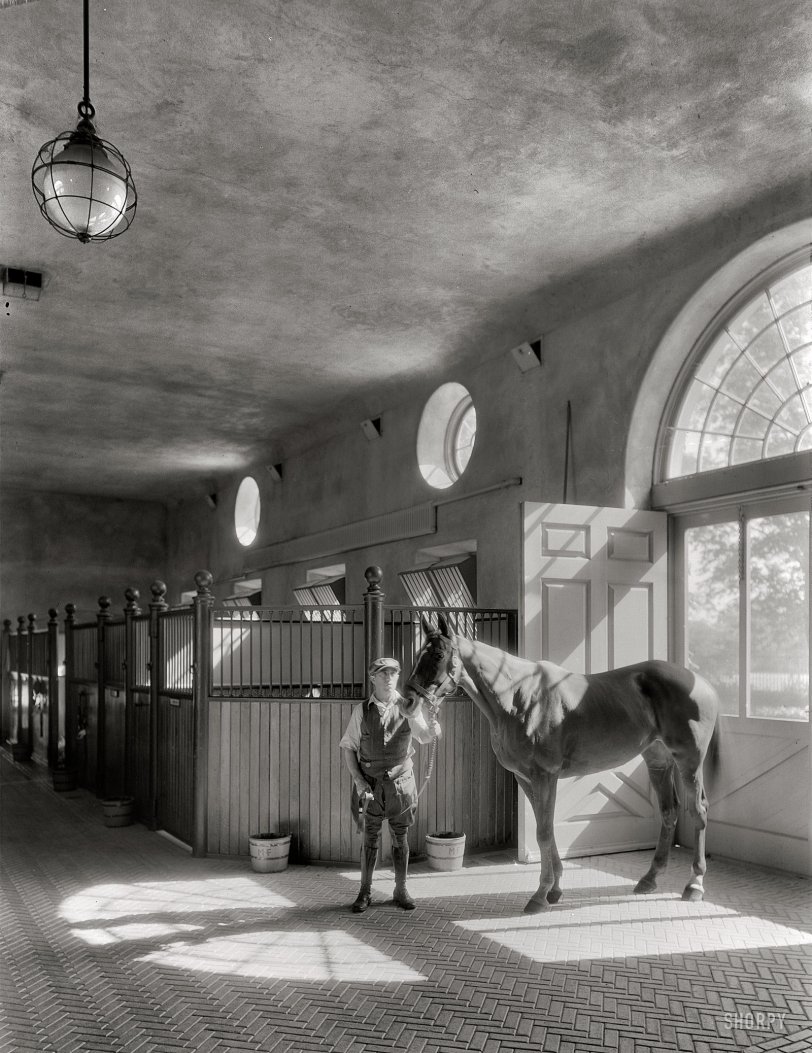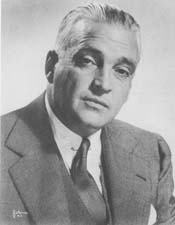


Framed or unframed, desk size to sofa size, printed by us in Arizona and Alabama since 2007. Explore now.
Shorpy is funded by you. Patreon contributors get an ad-free experience.
Learn more.

- Texas Flyer wanted
- Just a Year Too Soon
- WWII -- Replacing men with women at the railroad crossing.
- Yes, Icing
- You kids drive me nuts!
- NOT An Easy Job
- I wonder
- Just add window boxes
- Icing Platform?
- Indiana Harbor Belt abides
- Freezing haze
- Corrections (for those who care)
- C&NW at Nelson
- Fallen Flags
- A dangerous job made worse
- Water Stop
- Passenger trains have right of way over freights?
- Coal
- Never ceases to amaze me.
- Still chuggin' (in model form)
- Great shot
- Westerly Breeze
- For the men, a trapeze
- Tickled
- Sense of loneliness ...
- 2 cents
- Charm City
- What an Outrage
- Brighton Park
- Catenary Supports
Print Emporium
Caumsett Manor: 1933

October 12, 1933. Huntington, Long Island. "Marshall Field estate at Lloyd Neck. Interior view of polo stables." Gottscho-Schleisner photo. View full size.
Thanksgiving Dinner 1967
I had Thanksgiving dinner in the stable jockey's home to the side of this stable in 1967. A friend of a friend was a state trooper and his job was to patrol the estate. Some 1,600 acres, twenty five miles of paved road, some 25 other brick homes on the estate for gardeners, pastry chef, main chef, chauffeur, etc. At the time there were still about six or seven brand new looking blue 1957 Plymouth Sedans that had been left near a large garage area at the back of one the estate's larger buildings, I forget which one. The indoor tennis courts were still there but the glass ceiling had fallen in, very unsafe. As we approached his home by the stable I thought I saw a number of people standing around, but then I realized that they were statues! All the statues from the estate were placed in the stable for safe keeping! Amazing place, now open to the public (not everything). And that is a marvelous image of the interior of the stable and its marble floor tiles.
Marshall Field III
Next time you read Parade Magazine (presuming you might), you're holding something he founded:
Marshall Field III (1893-1956), who was the grandson of retail magnate Marshall Field, had a rheumatic heart condition, but was so keen to join the army during World War I that, instead of letting the enlistment board physical declare him ineligible for service, was sworn in as a private by a colonel and friend in the 1st Illinois Cavalry. He was discharged a captain in December of 1918. Field founded the Chicago Sun and Parade Magazine in 1941; the Sun merged with the Chicago Daily Times in 1948 to become the Sun-Times. He bought the publishing houses Simon & Schuster and Pocket Books in 1944. Field, who inherited the bulk of his family fortune in 1943, was also a philanthropist, serving as president of the Child Welfare League of America and the New York Philharmonic and as a trustee for the New York Zoological Society and Metropolitan Museum of Art. (Found at historyforsale.com)
I suppose I can mention that he was a principal financial supporter of Saul Alinsky.
His son, Marshall IV, as a USN officer on the carrier USS Enterprise, was awarded the Silver Star and a Purple Heart from action in the Battle of Santa Cruz. His grandson, Ted Field, is a Hollywood producer (Texas Chainsaw Massacre, Amityville Horror, etc.) and was quite active in auto racing for a number of years.
Here's MF III.

Great Picture
I really love this picture ... light, mood and composition is perfect!
Caumsett State Historic Park
Like Belle Meade
If you tour the Belle Meade plantation here in the Nashville area, you can see the carriage house and stables, which look an awful lot like this. We were assured by the tour guide that yes, the stable really was kept this neat, too. A horse has always been a pricey proposition, even if only used as transportation or a work animal, so a wise man of means made sure the animals were taken care of. Sort of like you could park your car outside under a tree where the birds can use it for target practice, or you can park it in a nice heated garage like Jay Leno.
Of course, both Caumsett Manor and Belle Meade represent the Jay Leno end of the spectrum. This surely isn't the mental image I conjure when I think of a stable, that's for sure.
[This is, as the caption notes, a stable for polo ponies. - Dave]
Caumsett State Park
This is in what is now Caumsett State Park, I have chaperoned several of my children's school trips to this wonderful place. Well worth a visit.
What Depression?
Remember, this was in the midst of the great depression and millions were living under bridges, in boxcars, Hoovervilles, waiting in soup lines and sleeping in doorways. The horses of Marshall Field enjoyed living conditions many humans would have found luxurious at this time.
Polo Barn Facade
The Golden Years
Caumsett
Marshall Field III's home wasn't just an estate, but a self-contained community. Built by architect John Russell Pope on 2,000 Lloyd Harbor acres -- the largest of the country tracts -- the Chicago-department store heir's 1925 compound included a working dairy farm with a herd of Guernsey cattle, stables, docks, cabanas, power plant and 25 miles of internal roads.
The house itself is a Georgian Revival modeled on Belton House, a manor near London. Outside the front door: a garden -- now a state park -- of broad landscapes and intimate spaces designed by the
OlmsteadOlmsted brothers, whose father created Central Park. "What is amazing about Field's house is that it was built very late in the country house era," says Lawrence, the Stony Brook architect. "Yet even in the Twenties, people still wanted grand houses."
Astonishing and ... Amazing
The tonal range indeed is amazing. You see detail in the doors and windows behind the horse, in the area on the floor under and in front of the horse and shadow detail in the stall exterior walls to the left. Looks like at least a three stop swing, maybe more. There had to be some forethought in how the negative was processed. All of this while Photoshop was still a several generations into the future and the idea of HDR wasn't even the impossible dream yet.
[Photoshop is used to bring out the detail in just about every image you see on this Web site. I used the Shadows & Highlights filter on this one. - Dave]
The Best
Nothing but the best for Marshall Fields' ponies. Steam heat radiator to keep everyone warm and toasty.
A very difficult exposure as well.
Anyone who has spent time making photographs will also note the difficulty of making this particular print, 65+ years ago. The light comes through the window from behind the pony. Yet the detail and tonality in his muscle and coat is terrific. Maybe could have been held back a tad on the horses back, but direct sunlight is really tough to deal with. No doubt a good deal of dodging and burning were required, along with skill with the light meter. Gottscho was a well established pro by 1933, but still, a great job.
[There is no print, hence no dodging or burning. This picture was made by imaging the original negative, which is then electronically inverted to give the positive you see here. I used the Shadows & Highlights filter in Photoshop to adjust the contrast. - Dave]
Edit -->> Oops on the print comment. Thanks Dave.
Wonder What
Orphan Annie would think about this "stable?" There's not a stick of straw on the floor, the woodwork is beautiful, and there's even a horse-sized door with a screen door!
Awesome!
That stable is nicer (and cleaner) than many people's homes.
Nice place
Holy crap. That horse lived in classier digs than I do. I wonder if they cleaned the place up for the photo.
It's spotless
Not the kind of condition I would expect to see in a stables.
"Francis"
Looks like an opening scene from "Francis the talking Mule"....The guy could even pass for Donald O'Connor. Francis says, "Get your arm out of my snout and hurry up with the oats."
Beautiful
No only is the horse gorgeous, look at the beautiful, spotless floor. These are very lucky horses.
Thought this looked familiar
If you saw the movie "Arthur" in 1981, they filmed a scene or two in these very stables.
Interesting to see the same stables so many years before -- beautiful!
Groom's Thoughts:
"Please don't mess up my floor!" Wow, that is the cleanest stable I have ever seen and I have seen a lot of them.
Polo Barn
Excellent! The polo barns at Caumsett, designed by John Russell Pope, are currently undergoing restoration. They have what I also consider to be the best preserved example of a "farm group," a type of barn complex built on estates in the late nineteenth and early twentieth centuries to house the operations for a gentleman's farm (in most cases, dairy cows were the focus, and Caumsett is no exception). Most of the North Shore Long Island great estates have been carved up or are in private hands -- this one is complete, and for the most part, open to the public. Caumsett is part of the New York State Parks system, and well worth a visit.
Nice stable
Even by today's standards, this is a very nice barn. If the stable hand was dressed in period-neutral clothes and the photo was in color, I would find it difficult to identify the era.
Old School HDR
Both this photo and the preceding one of 30 Rockefeller Center display an astonishing tonal range. Look at the way the highlights on the floor still show the pattern detail, and the shadow areas by the stalls are still open. I know that in the days of tray development, photographers would pull the negative from the developer and immerse in a tray of plain water for a minute or two before placing it in the stop bath. This would allow the shadow detail to keep developing and increase the effective tonal range of the image. Ansel Adams describes the technique in his book "The Negative" I wonder if this was one of Gottscho's techniques as well.

























On Shorpy:
Today’s Top 5